SUMMARY
Our clients came to us for help with a rather clunky prototype for a mobile application called Barly. This application would help novice to somewhat knowledgeable craft beer drinkers make better, more informed choices based on their individual taste preferences. The key feature of the design is the ability to photograph a printed beer menu through the use of OCR (optical character recognition) technology and then provide users with ratings, reviews, and information retrieved from BeerAdvocate's open API.
Throughout the project, the stakeholders showed enormous trust in us by allowing us complete creative freedom to design an efficient, thoughtful, and unique experience for their users.
CONSIDERATIONS
How great are users' needs for this application? Do drinkers of craft beer need or want help in making a beer selection? How genuine is the 'problem'?
How prevalent is the use of printed beer menus in bars, restaurants, and pubs that serve craft beers?
How are we going to keep users engaged if there is a wait time while the application is retrieving results from Beer Advocate?
How are we going to teach users to use the application?
What steps can we take in the design of the application to differentiate it from the competition?
CHALLENGES
Our biggest challenge, the one that required the most outside-the-box thinking, was in the approach to differentiating the application from the competition. Our stakeholders were definitely not 'first to market' with Barly. Applications like Picky Pint, SipSnapp, and Next Glass all solve the same the problem and even make use of the OCR camera scanning feature to connect users with beer ratings, reviews, etc. We could design the application in their image, and do it well, but to what end?
So how do we make Barly a killer app?
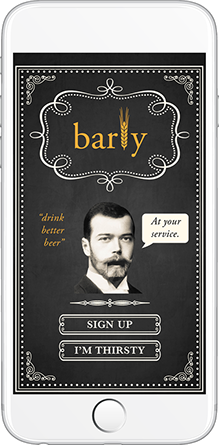
PROCESS & SOLUTIONS
As the visual designer, I was heading into the domain of branding when I conceived of a digital bartender/beer expert in your pocket, tentatively named 'Barly Tender' by my partner, Samantha Burke. I felt that having a character to engage, guide, and entertain the user, much like a good bartender does, would make the user journey a distinct, personal, and fun experience.
Greatly inspired by the early animated films of Terry Gilliam for Monty Python's Flying Circus, I paired a paper, cut-out bartender with a rather risky visual style reminiscent of an old pub chalkboard. Given the design flourishes, this is not exactly the norm for modern application design, and certainly a bit of a challenge given the limited real estate of mobile.
'Barly Tender' is a terrific fit for the pervasive sense of humor found in craft beer branding and beer drinking culture, in general.
VALIDATING USERS' NEEDS & THE BUSINESS MODEL
In our survey of 336 beer drinkers...
93.7% seek out craft beers at drinking establishments.
84.1% have a moderate to high interest in learning more about beer.
73.1% said the beer menu was the most influential factor in selecting a beer.
83.1% of drinking establishments that serve craft beer use a printed beer menu.
We had a hunch that our user research and our survey would validate users' needs for the application, however, we had to do our due diligence. We were pleasantly surprised by the strength of the results.
"Craft Beer and Consumer Behavior" (Garver, et al., 2014) provided a wealth of research and was most interesting in that it identified specific types of craft beer consumers. The majority of these consumers form a profile dubbed 'The Explorers'.
The most important behaviors of the Explorers as relates to their potential needs is their overwhelming preference for craft beer, taking great pride in continuously trying new beers, and a very solid interest in learning more about craft beer, in general.
It was also very satisfying to learn the use of printed beer menus is widespread and how often they were referenced by craft beer drinkers when making a selection. Obviously, this information is paramount to the validity of the business model for Barly.
USER PERSONA
Name: Brian Jones
Age: 27
Sex: Male
Race: White
Status: Single
Occupation: Sustainability Consultant
Craft Beer Profile: The Explorer
Favorite TV: N/A
Favorite Brands: Levi's, Converse, Goodwill, Moleskine
Favorite Music: Fleet Foxes
Favorite Film: Rushmore
Interests: Photography, Vinyl, Reading
Touch Points: Microbreweries, Pubs
Pain Points: Boredom, mainstream culture
Needs: Variety, new things, new experiences
Based upon our user survey...
86.6% are between the ages of 18-34.
84.7% are male.
67.5% hold a bachelor's degree or higher.
USER SCENARIO
Brian is meeting a friend for a beer after work at Father's Office in Culver City. He's early, so he surfs through his Facebook feed and catches sight of a post by a friend detailing a new beer he discovered through an app called Barly.

After surveying the beer menu, Brian realizes he isn't familiar with most of the offerings. Brian downloads the Barly app to help him make the best selection.
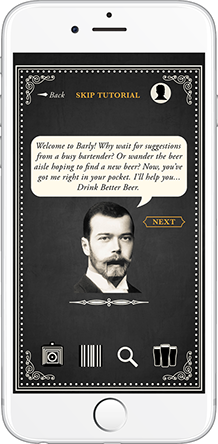
ONBOARDING NEW USERS & THE TUTORIAL
In service to their business goal of capturing users, we sought clarity from our stakeholders as to what point users would be expected to sign up. It was agreed that users would be given the option to sign up upon launching the app, but would only be required to sign up if they chose to leave a rating or share their beer choices with their friends through Facebook.
While we designed the tools and features of the app to be as intuitive as possible, we felt giving users a clear, concise tutorial would be thoughtful. In doing so, we tried to strike a balance between informing users of the tools and features of the app, yet allowing them the delight and sense of discovery of using them on their own. And, yes, the tutorial may be skipped altogether, if the user prefers.
Again, the use of a personality to serve as a friendly guide through the process helps create a narrative and furthers the emotional connection between the user and the application.
A value statement lets users know what needs will be satisfied.
We included a barcode scanning tool so that users may also use Barly at the grocery store or anywhere they discover a beer and would like to learn more about it.
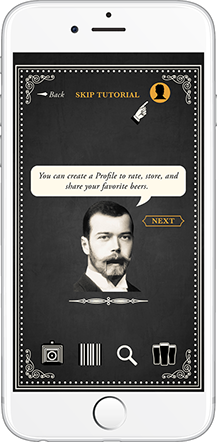
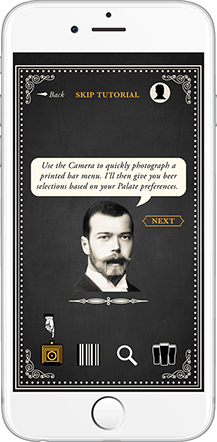
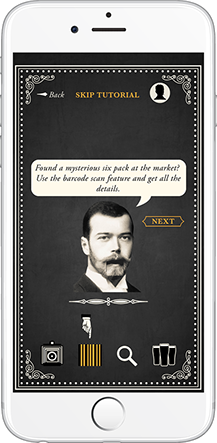
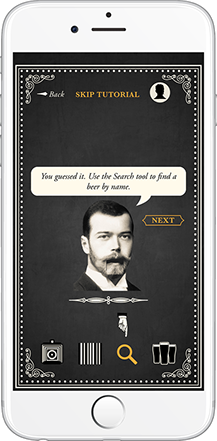
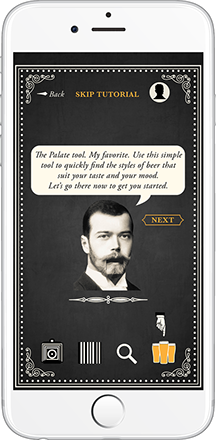
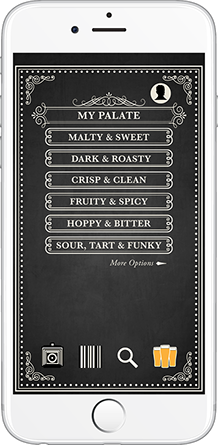
THE PALATE TOOL
This is the single, most important tool in the Barly arsenal in terms of matching users' taste preferences with the many styles of craft beer. It probably comes as no surprise to learn that it's taste, above all else, that guides choice. We wanted a simple, meaningful, go-to tool that could be used by any level of craft beer drinker. For more seasoned drinkers, we allowed for the option to make selections based on specific styles as well as by region.
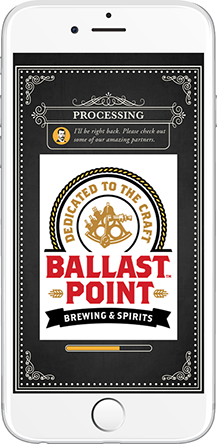
PROCESSING RESULTS
From the beginning, we expressed our concern with the potential frustration users might experience if they had to wait long for their results. We wanted our stakeholders and the development team to understand that it was critical that the processing time be kept to a minimum.
Whatever the wait time, we had to consider the user. The exact solution to this problem is predicated upon how long the wait time will ultimately be and remains a TBD item as of this writing.
For now, the solution is to advertise, which may offer genuine value to the business model, perhaps not so much to the user.
This time would be a terrific opportunity to entertain the user. As I offered before, I would love to see what users think about a short animation involving Barly Tender. But that's just me.
Be kind! Set the expectation with a progress bar.
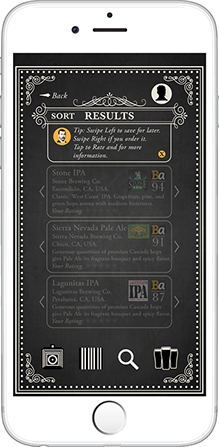
RESULTS & RATINGS
Menu photos, barcode scans, and ordinary searches are filtered in accordance with the user's palate preferences and displayed as tidy 'cards'. Users can then sort the cards via a familiar drop down menu of additional categories.
We struggled here with ways to continue the engagement between users and Barly Tender once their results were displayed. We knew we didn't want the relationship to end there. Who appreciates a disappearing bartender?
Our solution was to ask users to 'swipe right' if they actually order one of Barly's recommendations. This would subtly tell the Barly app you have actually ordered the beer as well as save it to My Beer History. It also starts a 'hidden timer' so that Barly may return in, say, 10 minutes to check-in with you and remind you to rate your beer.
Again, these efforts were all about creating an authentic and thoughtful experience for users.
Tips from Barly inform users how to save, rate, create a note, and share with friends. And, yes, they can be turned off.
Swipe right to save to your beer history
Users simply tap the number of stars to rate the beer, may make a note, and then share with friends.
After completing a rating, a record is saved under My Beer History in the user's profile.
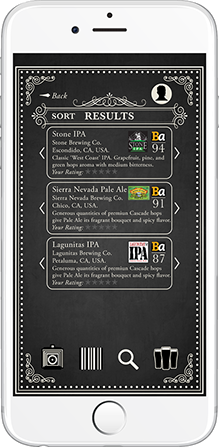
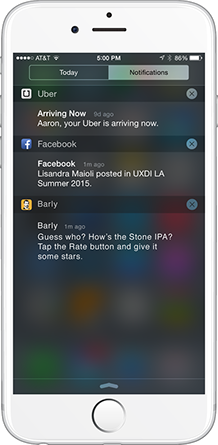
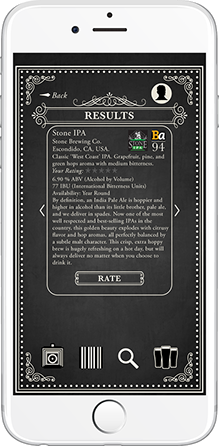
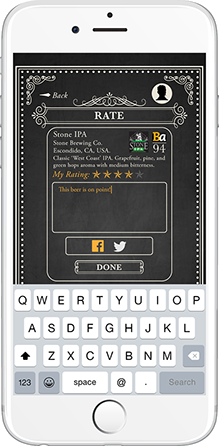
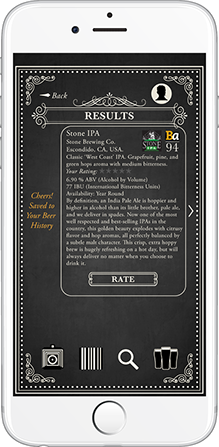
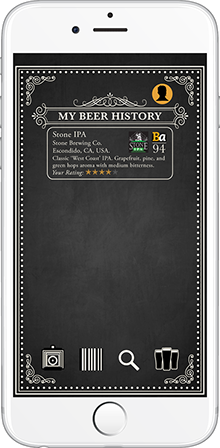
NEXT STEPS
The stakeholders are currently moving forward with fundraising efforts based on our design and we're also exploring options for gamification to help further user engagement and the fun of using the application.
In the meantime, I am planning to get out to some bars and pubs to participate in additional user testing of our design. Feedback will only make it that much better.
DOCUMENTATION
.jpg?crc=428692816)
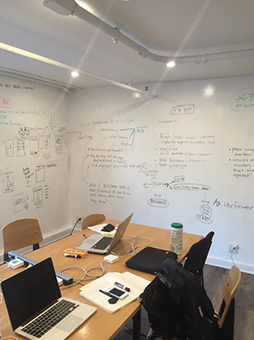
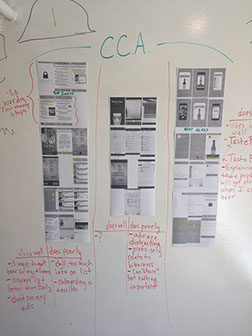
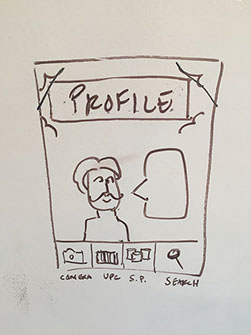
WEAPONS OF CHOICE



